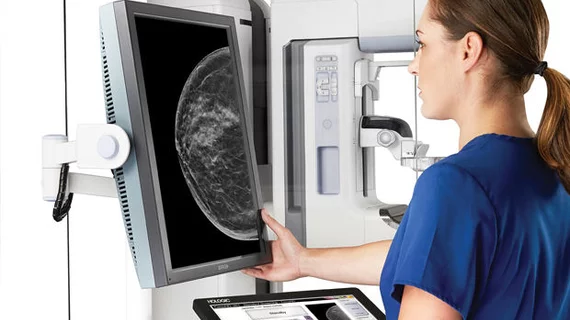Compared to using standard or full-field digital mammography (FFDM), administering mammograms with digital breast tomosynthesis (DBT) reduces the risk of benign biopsies while maintaining a favorable cancer detection rate, according to research out of the U.K.
While FFDM mammography has been a golden standard for detecting breast cancer for decades, DBT—also known as 3D mammography—is a more comprehensive approach to breast imaging, Nisha Sharma, MBChB, and colleagues at Seacroft Hospital in Leeds, England, said.
“The main advantage of DBT is its potential to improve the sensitivity and specificity of mammography,” Sharma and co-authors wrote in Radiology, where their work was published March 19. “It provides a series of thin-section images though the breast that reduces the effect of tissue superimposition or overlap, which often leads to cancers being missed or women without breast cancer being recalled for diagnostic workup after FFDM.”
To assess whether DBT would reduce that risk of tissue overlap and result in an improved sensitivity and specificity relative to standard mammography, Sharma et al. included 30,933 women in their single-institution study, all of whom had had a screening FFDM or breast MRI through the U.K.’s NHS Breast Screening Programme and followed up with DBT within six weeks of their initial appointment.
Of the study population, 1,470 women were recalled for further imaging for a recall rate of 4.8 percent, according to Sharma and co-authors’ work. A final recall group of 827 women after exclusions required 571 biopsies (a biopsy rate of 69 percent) that detected 142 cancers. Biopsies were benign in 75 percent of cases.
Reading the DBT images blinded to patients’ original FFDM screening results, the team found the inclusion of DBT imaging in initial appointments would have reduced the number of biopsies performed on recalled women from 571 to 298 while still detecting 142 cancers. DBT yielded a biopsy rate of 36 percent and a benign biopsy rate of 52 percent.
“In our study, DBT as a screening tool would have reduced the number of women recalled for diagnostic workup by 71.4 percent,” Sharma et al. wrote. “In doing so, we would have missed two of 145 cancers that were screen detected with FFDM alone, but we would have identified two of 145 cancers that were not detected with FFDM.”
The authors said DBT assessments also had “significantly” higher specificity than standard mammography without DBT—77.5 percent and 38.2 percent, respectively. Their results indicated 273 biopsies could have been avoided had DBT been used.
“DBT allows for improved reader accuracy and confidence in determining if a mammographic abnormality is concerning for cancer or not, leading to a reduction in the number of biopsies performed,” they wrote. “Our study demonstrates that DBT showed higher specificity across a range of feature types, especially mass lesions and asymmetric densities, which is consistent with the current literature.”

